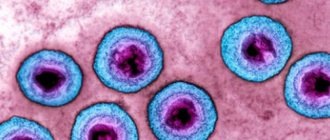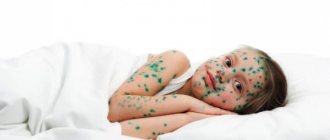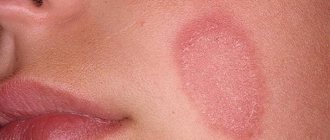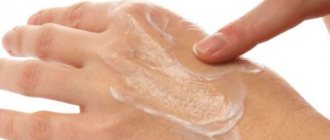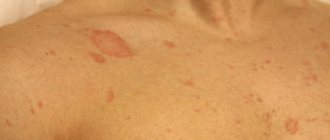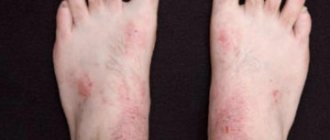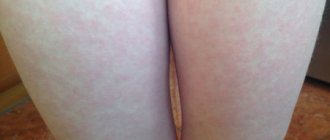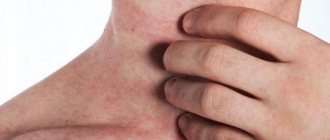Features of chickenpox in adults
It is quite rare to get chickenpox in older people, since the infection in most cases is diagnosed at a younger age. As a rule, children studying in kindergartens and primary grades suffer from chickenpox.
The main cause of chickenpox is a virus called Varicella-Zoster. It can only exist in the conditions of the human body. In the environment, its lifespan is no more than 15 days.
It enters the body through the nasal passages. The main route of infection is airborne. Therefore, if someone in the family catches an infection, then the probability that it will affect others is 90%. Moreover, those who get sick later will suffer from chickenpox much more severely with a large number of rashes.
The incubation period is 14-17 days. During this time, the virus begins to spread on the mucous membranes of the nasal cavity, then with the help of the tonsils they penetrate the lymph system.
After suffering from chickenpox, a person develops immunity for life. So he won't be able to get sick again? It doesn't always happen this way. There are situations when chickenpox occurs again. This happens when immune functions are weakened.
After suffering from chickenpox, a person develops immunity for life
In adults, chickenpox goes through six stages:
- After multiplication in the upper respiratory tract and lymphatic system, the activity of T lymphocytes decreases.
- When the latent period comes to an end, Varicella-Zoster enters the blood. This leads to an increase in temperature and signs of intoxication.
- The virus then settles in the nerve ganglia. It is activated when the immune system is weakened.
- Viral cells penetrate the epidermis, which provokes the appearance of bubbles filled with liquid. In adults, papules may fester.
- Then the pustules are opened, the liquid pours out of them. In place of the papules, a watery crust remains, which dries out over time.
- The skin tightens.
From the first days of the disease, the immune system begins to produce immunoglobulins that absorb viral particles. Antibodies remain in the blood of a person who has previously had chickenpox forever, which protects against secondary manifestations of infection.
Symptoms in children
The first clinical manifestations begin to appear several days before the appearance of rashes on the skin of the body, and they are in many ways reminiscent of a common cold:
- body temperature rises;
- aches throughout the body;
- sore throat;
- cough;
- general weakness.
After which, after 2 days, rashes begin to appear on the surface of the skin and mucous membranes, while the emerging bubbles are filled with transparent contents. The appearance of a rash provokes the development of severe itching, which can intensify at night. The rash can be single or multiple on any part of the body.
In severe cases, the rash is located everywhere, including on the scalp. The period of appearance of new rashes lasts from 3 to 5 days, after which the blisters burst. The resulting ulcerative defects are covered with dry crusts, which should not be removed due to the risk of scars remaining after healing.
How and how long do adults get chickenpox: symptoms
The vast majority of the disease occurs in children and adolescents. It is easy and does not require complex treatment. In adults, it’s the opposite: the symptoms are extremely difficult to tolerate, and serious complications often occur. Even cases of death have been recorded.
So how does chickenpox go away in adults? The chickenpox virus is transmitted by airborne droplets. That is, there is a high probability of infection even after a normal conversation with a patient. Moreover, the disease can be transmitted both from a baby and from an adult with shingles - chickenpox and shingles have the same pathogen.
In most adults, the disease manifests itself sharply and acutely:
- The first typical symptom is a rash, which looks like small round pinkish spots with clear boundaries;
- At the same time, the temperature rises, which can reach 40°C;
- In the first days, symptoms of intoxication of the body are strongly expressed;
- Sometimes there is vomiting, photophobia, irritation from sharp sounds, impaired coordination of movements;
- Enlargement of the cervical, submandibular, axillary, and inguinal lymph nodes.
When they talk about recurrence of chickenpox, they mean shingles. With relapse, symptoms are less pronounced. Regardless of how long the illness lasts, with the new appearance of rashes, health, as a rule, worsens.
In childhood/adolescence, chickenpox occurs without consequences. Typical symptoms are rashes and fever. Therapy consists of treating the rash with brilliant green and taking antipyretics.
But adults tolerate the disease worse. Many people experience headaches and general malaise. And if a sick child is awake, then an adult will adhere to bed rest.
Periods of infection
Chickenpox is divided into 4 stages of development, with each of them characterized by its own characteristics, manifestations and duration:
The period of incubation of the infection, also called the latent period or latent form of the disease. During this period of time, which begins from the moment of infection, processes that are invisible to the eye occur.
At the same time, the person feels healthy throughout the entire stage and only at the final stage, in the last 2-3 days, the patient may experience some weakness and general malaise, which are often attributed to fatigue and lack of sleep. The incubation period in adults lasts on average 14-18 days;
What happens in the body? At this stage, the virus adapts to new conditions and gains a foothold, penetrating healthy cells of the mucous membranes and upper layers of the dermis. Next, the virus replaces the DNA chain of the cellular system for producing protein material with its own (the virus carries the DNA chain in its body). At the same time, the cell continues to actively perform the production function, “unaware” that it is producing a virus that accumulates in this cell.
Then the cell is destroyed (disintegrates) and a huge number of viruses hidden in it are released and the cycle repeats. Subsequently, the infectious agent spreads throughout the body through the blood and lymphatic fluid, provoking infectious poisoning of the entire body (intoxication).
During this period, another very important process occurs - the development of an immune response. This process is extremely complex, but in short, B-lymphocytes, through the influence of the viral antigen, are converted into plasma cells, which begin to produce specific glycoprotein antibodies, which subsequently play a key role in the fight against the viral threat.
Prodromal or premonitory period. It is believed that during this period of time, infectious poisoning reaches the required level, and the body launches the mechanisms necessary to fight the infection. Due to these two factors, symptomatic manifestations appear:
- increase in temperature level, often reaching 39-40 degrees;
- nausea, possible vomiting;
- acute headache;
- pain in joints and muscles throughout the body;
- spasms and cramps of individual muscle groups. When the temperature reaches above 39 degrees, involuntary twitching of the limbs may be observed;
- general weakness and lethargy of the whole body;
- chills/fever;
How long does an adult suffer from chickenpox at this stage? The prodromal period begins with the appearance of the first symptoms and ends with the transition to the next stage of development - the period of rashes. As a rule, it is 1-3 days. The symptoms do not disappear, but only increase their severity;
All these symptoms resemble manifestations of an acute respiratory disease, which greatly complicates the diagnosis of the disease at this stage of the infection.
Rash period. During this period of time, the first elements of the rash appear and this period lasts until the last foci of exanthema appear. Chickenpox rashes are polymorphic in nature, that is, they go through several stages of development, transforming and changing.
The first rashes look like red-pink spots and are called roseola. They are usually localized on the skin of the face and scalp (in the scalp). After a short period of time, maximum within a day, roseolas turn into papules: a small compaction-nodule forms in the middle, which is slightly raised above the general surface. Externally it resembles a pimple. In this case, foci of exanthema begin to appear throughout the body: on the arms and legs, shoulders, hips, abdomen, chest, etc.
In addition, depending on the severity of the infection, rashes can form on the mucous membranes of the mouth, throat and nose, in the groin area, on the genitals and even on the organs of vision (on the eye) and the periocular area. In the form of papules, the rash does not last long and within 24-48 hours again changes its “appearance”, transforming into vesicles. The nodules begin to fill with clear liquid containing a huge concentration of the infectious agent and increase in size, filling almost the entire area of the spots.
Vesicles look like small bubbles with a reddish rim. Within 24-48 hours, the blisters dry out and begin to become covered with a characteristic brown crust, which disappears after 6-10 days, leaving behind small pink or red spots. Residual spots also disappear on their own.
How many days do adults suffer from chickenpox during the rash period? As a rule, in adult members of society this stage lasts from 7 to 12 days;
Chickenpox rashes are often accompanied by a strong desire to scratch the affected areas of the skin. This is prohibited, since if the integrity of the vesicle is damaged, there is a possibility of harmful bacteria entering the resulting wound, which can provoke the development of a bacterial infection. And this significantly complicates the course of the disease and after such a complication, deep skin disorders often remain in the form of scars, which are quite difficult to get rid of.
Recovery period. At this stage, the infection recedes: the temperature decreases and gradually returns to normal, new elements of the rash do not appear, and the patient feels an improvement in his general condition. It is believed that within 5-6 days from the moment the last foci of exanthema appear, a person is sick;
Atypical forms of chickenpox
In this part of the article we will look at atypical types of chickenpox, which are quite rare. There are 4 atypical forms of the disease:
- Rudimentary or asymptomatic chickenpox. With this course of infection, the appearance of a papular rash occurs in very small quantities, and the temperature may not be observed at all or may be low-grade in nature. For this reason, a person himself does not know that he is sick, and a slight weakness is attributed to fatigue or a minor cold. With this form, the rash can last 2-3 days;
- Gangrenous chicken pox. Chickenpox pimples with this manifestation of infection change - they increase in size, and the contents of the blisters become cloudy due to purulent processes occurring in the skin tissues. The rash, in this form, is treated with a course of antibiotics and takes a long time to heal. Gangrenous chickenpox itself is treated exclusively with hospitalization of the patient. Pimples can last more than 12 days;
- Hemorrhagic chicken pox. It is characterized by infection of blood vessels, the rash increases in size, and an admixture of blood is added to the contents of the rash. It is very difficult to treat and under the supervision of a doctor, due to the severe infection of the body. As a rule, this type of infection proceeds intensively. Possible death. The rash may last more than 12 days;
- Generalized chickenpox. There is widespread, severe infection of the entire body; the rash appears everywhere, including internal organs and eyes. He is being treated in a hospital. The rash lasts for more than 12 days;
Note that rudimentary chickenpox is extremely rare in adults. The reasons for its appearance are: recent completion of a course of immunostimulation using immunoglobulin, as well as emergency prevention of chickenpox using immunoglobulin or a live vaccine.
Hemorrhagic and generalized types of chickenpox can only be observed in people who have a suppressed immune system, after undergoing a specific course of treatment (after chemotherapy) or immunodeficiency (with HIV infection or AIDS).
The gangrenous nature of the infection occurs, as a rule, due to harmful bacteria entering the bloodstream when scratching the rash. With timely and correct therapy, this form is excluded.
Having examined the forms of chickenpox and the cause of the rash, we can begin to ask the question: “How many days does chickenpox last in adults?”
How many days does it take - signs of recovery?
The recovery period takes from several days to several weeks. During recovery, blisters and rashes gradually disappear from the skin. If the rules of antiseptic treatment are not followed, there is a chance that the blisters will begin to fester, which can prolong the course of chickenpox.
The beginning of recovery is characterized by the following signs. New rashes stop appearing on the skin. The crusts that have formed at the sites of the blisters begin to fall off. The most important factor in the length of the recovery period is the state of the immune system, since if the immune system is weak, treatment will take a longer period than in a situation where the immune system works well.
The recovery period takes from several days to several weeks
Eventually
Based on the above, we can say that the duration of the appearance of a rash with chickenpox directly depends on the severity of the infectious lesion.
How many days does it take to have chickenpox? In fact, new rashes can appear within 4-12 days in typical forms of the disease and within 2-16 or more days.
How to speed up the healing process of chickenpox acne? To reduce the impact of the virus on the body and to speed up the treatment process for chickenpox, antiviral drugs may be prescribed. The most common antiviral agent with activity against herpes viruses is Acyclovir. The use of ointments and tablets of the same name significantly reduces the duration of the appearance of the rash in chickenpox.
Please note that if the infection is mild, it is not recommended to use Acyclovir.
How to treat chickenpox
To avoid scratching the blisters and causing infection, it is necessary to treat the points where the blisters appear with brilliant green or fucorcin. Fucorcin contains acetone, which can cause allergies, so it can be used to treat acne no more than twice a day. Diamond green is a safer drug, so it can be used up to four times a day.
There are other means for treating rashes: furatsilin, a five percent solution of potassium permanganate and others. These drugs dry out the chickenpox blisters and speed up their healing process.
To avoid complications with chickenpox, you must adhere to bed rest. It is necessary to exclude the appearance of suppuration on the blisters; to do this, you need to thoroughly wash your underwear and clothes. After eating, it is recommended to rinse your mouth vigorously. During illness, be sure to maintain water balance - drink plenty of fluids. Avoid overheating the body, as sweat increases the itching.
The rash should not be moistened with water, as this can lead to complications associated with bacterial infection of the blisters, in which purulent skin lesions are noted. Therefore, it is necessary to exclude water procedures until three days have passed since the last bubbles appeared.
Complications of the virus
How long chickenpox lasts in adults largely depends on following your doctor’s recommendations. If the patient does not adhere to bed rest, ignores taking medications, and constantly scratches the rash, the easiest of the complications will be the addition of a secondary infection. You can recognize it by the presence of pus in the pustules; the ulcers will become inflamed. In place of the pustules, necrosis forms and, ultimately, the skin becomes covered with scars.
Due to intoxication of the body during smallpox, the liver may be damaged. If the whites of an infected person's eyes turn yellow, go to the hospital immediately. A patient of retirement age may exhibit cardiovascular pathologies and pneumonia. In people with bad habits, untimely therapy can cause a cyst in the brain, meningitis and encephalitis. These diseases will lead to disability or death without timely treatment.
Separately, I would like to note that during the acute course of the disease, patients should reduce physical activity and eye strain. It is vision pathologies that are the most common complication in people after 40 years of age.
Now you know how many days the chickenpox quarantine lasts in adults and how long adults suffer from chickenpox. Such awareness will allow you to start treatment in a timely manner, protect your loved ones from infection and avoid most complications. There has been a special vaccine against chickenpox in the world for a long time.
It allows you to protect yourself from the virus at any age. Even if a person has been in contact with a patient for some time, but has been vaccinated within 72 hours, the virus does not become active. All doctors agree on one thing: it is easier to prevent the Varicellovirus virus than to deal with its consequences and symptoms. That is why it is recommended to think about vaccination for yourself and your family.
Chickenpox rash stages
If a patient suspects he has chickenpox, symptoms may include:
- First of all, the patient begins to develop fever and high temperature;
- Constant headache;
- The glands may become swollen;
- A rash gradually appears;
- Lost appetite and stomach pain.
The rash consists of blisters that cover the entire body and become very itchy. It is not recommended to scratch them, because they will begin to spread even more throughout the body.
Chickenpox in adults after illness in childhood
There is also information that when undergoing chemotherapy and hormone therapy, after any transplantation of tissues and internal organs, if the immune system is suppressed, a person can get chickenpox again. If there is stress or any chronic diseases, the virus can manifest itself in an adult in the form of a severe herpes rash.
Quite often you can observe a recurrence of chickenpox in adolescents - they have a decrease in immunity due to hormonal surges that occur during growing up. Chickenpox can be contracted from both a child and an adult who has shingles, since this disease is caused by the same virus that activates chickenpox in the human body.
Finally
In this informational article, we talked about the contagiousness of chickenpox, namely how long chickenpox is contagious after the rash. If you suddenly become ill with this infection, follow the quarantine regime, since chickenpox can lead to extremely tragic consequences. For example, in pregnant women, this disease can cause miscarriage, fetal death, or the development of all possible pathologies and deformities in the child.
For children under 1 year of age, this infection can also be fatal or cause serious health problems. In adults, with a normal body's natural defense system, chickenpox can take a severe form, which is accompanied by an extremely aggressive degree of symptomatic manifestations and numerous rashes, which can also leave marks for life.
Do not be ill. And if you get sick, don’t infect others.

